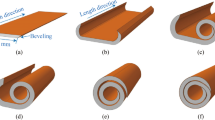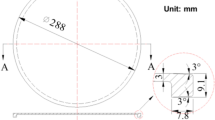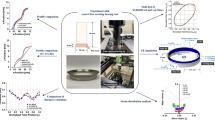Abstract
Double-roll rotary forging is an emerging plastic forming technology based on rotary forging. Owing to the advantages of labor saving, small eccentric load, low noise and vibration, good uniformity, high surface quality, and material saving, it is very promising for fabrication of large-diameter thin-walled disc. To date, a few relevant researches on the double-roll rotary forging technology of large-diameter thin-walled metal discs have been reported, and the forming mechanisms and process of disc workpieces remain uninvestigated. Herein, a 3D rigid-plastic finite element model (FEM) is established to simulate the fabrication process of large-diameter thin-walled disc; four geometric features appear in the forming process: “mushroom” shape, “upper drum” shape, “drum shape” shape, and “lower drum” shape. Equivalent stress, equivalent strain, and temperature field of these four geometric shapes are analyzed, and the forming mechanism of these four geometric shapes is revealed. The reliability and accuracy of FEM are verified through experiments, and the four geometric shape features occur in the process are consistent with the simulation. The research results provide valuable guidelines for better understanding of double-roll rotary forging for the fabrication of large-diameter thin-walled discs.










Similar content being viewed by others
Availability of data and material
The datasets used or analyzed during the current study are available from the corresponding author on reasonable request.
Code availability
All software used in this article is licensed.
References
Li QH, Wu LB, Li FG, Liu TY, Wang SG, Wei ZJ, Su CM (2013) Experiments study on the rolling process for heavy disk. Int J Adv Manuf Tech 65:1171–1175
Ma Q, Lin Z-Q, Yu Z-Q (2009) Prediction of deformation behavior and microstructure evolution in heavy forging by FEM. Int J Adv Manuf Tech 40:253–260
Zhbankov IG, Perig AV, Aliieva LI (2016) New schemes of forging plates, shafts, and discs. Int J Adv Manuf Tech 82:287–301
Li Q, Ma Z, Liu T, Li F, Wei Z, Su C (2014) 3D thermomechanically coupled FEM analysis of large disk rolling process and trial production. Int J Adv Manuf Tech 74:403–411
Peng W, Zhang D, Zhao D (2017) Application of parabolic velocity field for the deformation analysis in hot tandem rolling. Int J Adv Manuf Tech 91:2233–2243
Zhou P, Zhang L, Gu S, Ruan J, Teng L (2014) Mathematic modeling and FE simulation of radial-axial ring rolling large L-section ring by shape axial roll. Int J Adv Manuf Tech 72:729–738
Canta T, Frunza D, Sabadus D, Tintelecan C (1998) Some aspects of energy distribution in rotary forming processes. J Mater Process Technol 80–81:195–198
Decheng Z, Yadong H, Wang ZR (1992) Research on rotary forging and its distribution of deformation. J Mater Process Technol 31:161–168
Wang GC, Guan J, Zhao GQ (2005) A photo-plastic experimental study on deformation of rotary forging a ring workpiece. J Mater Process Technol 169:108–114
Oudin J, Ravalard Y, Verwaerde G, Gelin JC (1985) Force, torque and plastic flow analysis in rotary upsetting of ring shaped billets. Int J Mech Sci 27:761–780
Oh H-K, Choi S (1997) Ductile fracture in the central region of a circular plate in rotary forging. J Mater Process Technol 68:23–26
Oh HK, Choi S (1997) A study on center thinning in the rotary forging of a circular plate. J Mater Process Technol 66:101–106
Zhou DC, Yuan SJ, Wang ZR, Xiao ZR (1992) Defects caused in forming process of rotary forged parts and their preventive methods. J Mater Process Technol 32:471–479
Liu G, Zhang LB, Hu XL, Wang ZR, Wang RW, Huang SD, Tang QB (2004) Applications of numerical simulation to the analysis of bulk-forming processes - case studies. J Mater Process Technol 150:56–61
Liu G, Yuan SJ, Wang ZR, Zhou DC (2004) Explanation of the mushroom effect in the rotary forging of a cylinder. J Mater Process Technol 151:178–182
Yuan SJ, Wang XH, Liu G, Chou DC (1999) The precision forming of pin parts by cold-drawing and rotary-forging. J Mater Process Technol 86:252–256
Han XH, Hua L (2009) Comparison between cold rotary forging and conventional forging. J Mech Sci Technol 23:2668–2678
Han XH, Hua L (2009) 3D FE modeling of cold rotary forging of a ring workpiece. J Mater Process Technol 209:5353–5362
Han XH, Hua L (2010) Deformation characteristics and mechanisms of the cold rotary forging of a ring workpiece. J Strain Anal Eng 45:97–114
Han XH, Hua L, Wan XJ (2012) Effect of equivalent feed amount per revolution on cold rotary forging process by 3D elastic-plastic dynamic explicit FE method. Ironmak Steelmak 39:10–19
Hua L, Han X (2009) 3D FE modeling simulation of cold rotary forging of a cylinder workpiece. Mater Des 30:2133–2142
Han XH, Hua L (2012) Friction behaviors in cold rotary forging of 20CrMnTi alloy. Tribol Int 55:29–39
Han XH, Hua L (2011) Prediction of contact pressure, slip distance and wear in cold rotary forging using finite element methods. Tribol Int 44:1742–1753
Han XH, Hua L (2012) Investigation on contact parameters in cold rotary forging using a 3D FE method. Int J Adv Manuf Tech 62:1087–1106
Han XH, Hua L (2013) 3D FE modelling of contact pressure response in cold rotary forging. Tribol Int 57:115–123
Han XH, Hua L (2013) 3D FE modeling simulation for wear in cold rotary forging of 20CrMnTi alloy. J Tribol ASME 135
Wang H, Liu D, Zhang F, Zhang Z, Wang J, Yang Y (2021) A comparative study on the evolutions of thermal and mechanical parameters and microstructure of 30Si2MnCrMoVE steel during hot ACDR and upsetting deformation. Int J Adv Manuf Tech 114:579–589
Zheng Y, Liu D, Qiu S, Wang S, Wei L, Wang Z, Tian D (2019) Effect of deformation routes on torsion behavior via ACDR process. Int J Adv Manuf Tech 104:4105–4116
Zheng Y, Liu D, Yang Y, Zhang Z, Li X (2017) PDZ evolution of hot ACDR and forging processes during titanium alloy disc forming. Int J Adv Manuf Technol 95:1635–1643
Zheng Y, Liu D, Yang YH, Ren LJ, Zhang Z, Gao GJ (2016) Investigation on metal flow during the hot axial closed die rolling process for titanium alloy discs. Int J Adv Manuf Tech 87:2445–2458
Shi L, Zhu C, Liu X, Zhang Y (2020) Optimum design of the double roll rotary forging machine frame. Mech Sci 11:101–114
Tian D, Han X, Hua L, Huang B, Yang S (2020) A novel process for axial closed extrusion of ring part with mesh-like ribs. Int J Mech Scie 165
Zhuang W, Han X, Hua L, Xu M, Chen M (2019) FE prediction method for tooth variation in hot forging of spur bevel gears. J Manuf Process 38:244–255
Funding
The National Natural Science Foundation of China (No. 51875427) provided the support to this research.
Author information
Authors and Affiliations
Contributions
Zhongquan Yu and Chundong Zhu proposed the idea and performed the theoretical work. Zhongquan Yu and Chundong Zhu completed the writing of the paper. Zhongquan Yu, Mingchao Chen, and Site Luo performed the experimental work.
Corresponding author
Ethics declarations
Ethics approval
Not applicable.
Consent to participate
We would like to declare that the work described has not been published previously and not under consideration for publication elsewhere, in whole or in part.
Consent for publication
All the authors listed have approved the manuscript that is enclosed.
Competing interests
The authors declare no competing interests.
Additional information
Publisher's note
Springer Nature remains neutral with regard to jurisdictional claims in published maps and institutional affiliations.
Rights and permissions
About this article
Cite this article
Yu, Z., Zhu, C., Chen, M. et al. Forming characteristics and mechanism of double-roll rotary forging for large-diameter and thin-walled metal discs. Int J Adv Manuf Technol 119, 7543–7555 (2022). https://doi.org/10.1007/s00170-022-08765-5
Received:
Accepted:
Published:
Issue Date:
DOI: https://doi.org/10.1007/s00170-022-08765-5




